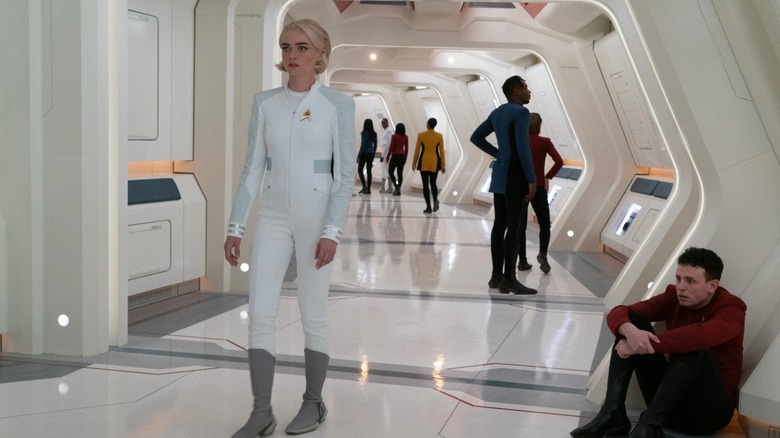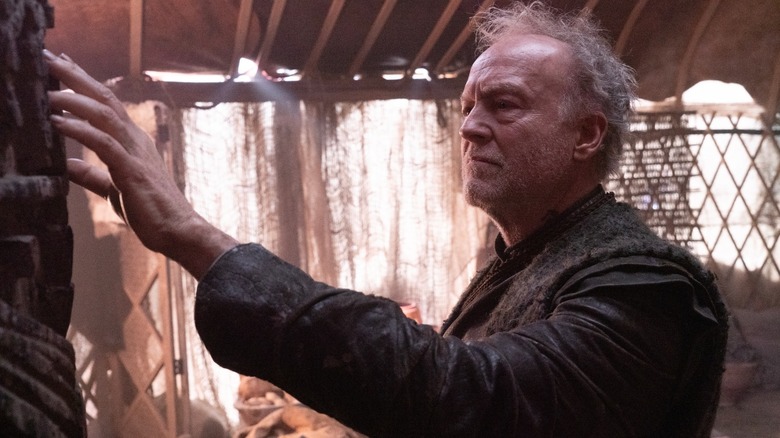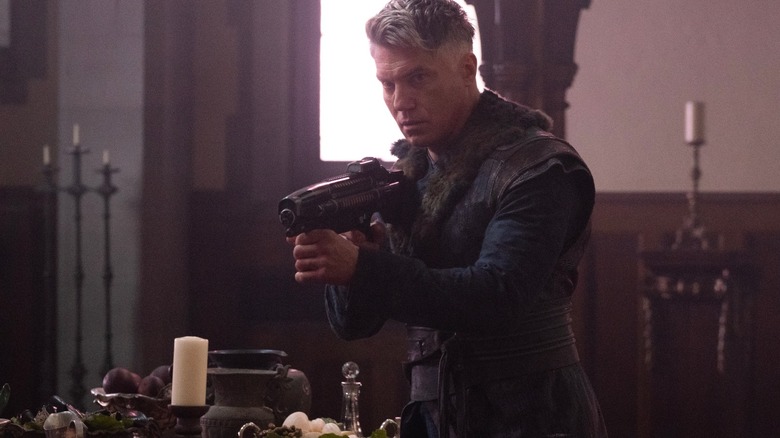The Latest Star Trek: Strange New Worlds Is Directed By A Horror Master
The most recent episode of "Star Trek: Strange New Worlds," called "Among the Lotus Eaters," follows the U.S.S. Enterprise to the planet Rigel VII which has an eerie and damaging effect on the crew. It seems that anyone on the planet — or in orbit — begins to experience massive memory loss. Basic things like language and learned skills remain in their brains, but the entire crew begins to forget their names, the name of the ship they're on, and anything related to their identity. Halfway through the episode, there's an unnerving scene where the crew is all wandering the corridors of the Enterprise, looking at each other, looking at the walls, and not recognizing anything. Naturally, they're all confused and terrified.
When it first began in 1966, "Star Trek" might rightly have been described as a horror program. The first season features multiple monsters and murders, each one more terrifying than the last. Little kids likely recall the nightmare-inducing visage of Balok, the evil-looking alien from "The Corbomite Maneuver." Or the scene in "Charlie X" wherein the title character uses his spiteful godlike powers to make a woman's face disappear. The horror elements of "Star Trek" would reappear from time to time over the franchise's history. One of the scariest things of all time is the scene in the "Star Trek: The Next Generation" episode "Night Terrors" when Dr. Crusher (Gates McFadden) finds herself in a morgue ... and the bodies begin sitting up on their own. Even "Strange New Worlds" already dabbled in horror with the episode "All Those Who Wander" in its first season.
It should surprise readers to learn, then, that "Lotus Eaters" was directed by a known horror luminary, Eduardo Sánchez, the co-director of the 1999 earth-shattering hit "The Blair Witch Project."
Eduardo Sánchez
The legend is familiar to those who were there when "The Blair Witch Project" first hit: Sánchez and his co-director Daniel Myrick met each other while students at the University of Central Florida. Inspired by the 1922 Swedish horror movie "Häxan," the nascent filmmakers elected to make a horror movie that blended horror elements with a documentary aesthetic. The eventual result was a film they shot in the woods of Maryland for about $60,000, all about a witch that might live there and the young documentarians who unwittingly infiltrated her terrain. Their actors were also the cinematographers and a lot of the dialogue and horror scenarios were improvised. The film made over $140 million, making it one of the biggest hits of all time in relation to its budget.
While a sequel was rushed into production — "Book of Shadows: Blair Witch 2" came out only 15 months after the original — Sánchez and Myrick weren't directly involved in its making. Indeed, it would take Sánchez several more years before his follow-up project, a 2006 low-budget horror film called "Altered." That film was a more traditional gore-fest clearly inspired by the early works of Sam Raimi. In terms of features, Sánchez continued to make low-budget horror movies over the years, including "Lovely Molly," "Exists," and "Butterfly Kisses." The latter two were found-footage films like "Blair Witch."
On television, though, Sánchez has worked on some of the more high-profile shows of the last 15 years, including "Supernatural," "Lucifer," "American Horror Story," "Yellowjackets," and "Charmed." It seems that Sánchez is versatile and in demand. He now has experience working on "Star Trek."
Coming back to Star Trek, again and again
Even at this late date, "Star Trek" is still typically very good to its own. Even going back as far as the original 1966 pilot, "Star Trek" has welcomed back actors and directors with casual frequency, as when Majel Barrett played Number One in "The Cage," and Nurse Chapel in the main series. Many regular Trek actors began in the franchise in other roles, and minor characters would see their roles expand as time passed. There's no way, for instance, that actor Colm Meany could have known that his role as a functional transporter chief on "Star Trek: The Next Generation" would eventually lead to a regular central role on "Star Trek: Deep Space Nine."
Sánchez, then, has joined a family of artists that tend to reunite again and again. With one episode of "Star Trek" comes another and another. There's every reason to believe he'll be asked back at least two or three more times to direct. If he displays the kind of mood and panache he did with "Lotus Eaters," then it becomes even more likely. Although "Star Trek" may be contracting in general, Sánchez could easily step in from time to time to direct "Strange New Worlds," "Star Trek: Discovery," or even the upcoming "Starfleet Academy."
And not necessarily the horror episodes. Sánchez has proven he can handle any sort of material. There's no reason not to give him a courtroom episode, an ethics episode, or a comedy episode.
"Lotus Eaters" is simply a clear signal that a successful filmmaker who started small continues to operate comfortably in the big time.


